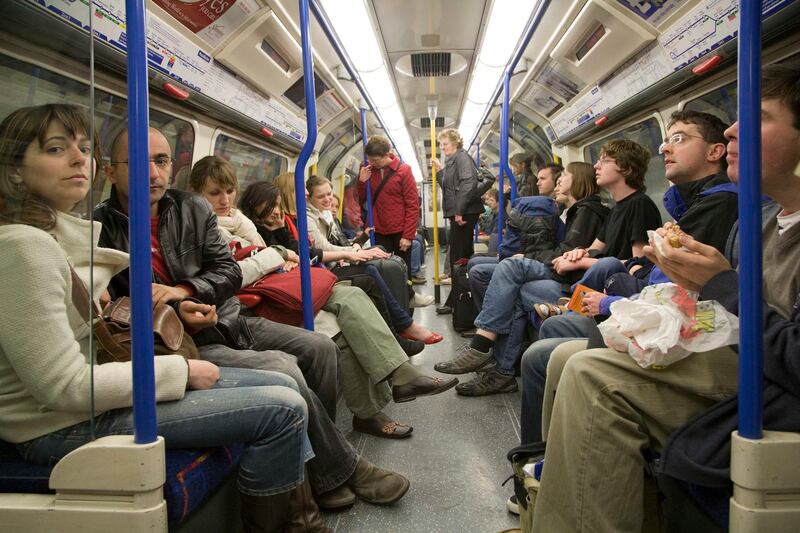The 4.8 million passengers who use the London Underground every day are facing pollution dangers despite escaping the exhaust fumes and soot of road travel.
Although its health risks have been little studied and little publicised, other than a handful of recent scientific papers, the London Underground is by far the most polluted part of the city. Fine particles of dust, metal, skin and clothing fibre have built up in the tunnels over a century of use, leaving a toxic miasma that is stirred up by passing trains and inhaled by passengers.
A Financial Times investigation has mapped the air quality in the carriages of the London Underground. Using hundreds of measurements covering 75 tunnel segments inside Zone 1 in central London, the investigation found that levels of pollution on the Underground are dangerously high - as much as 10 times above the guidelines set by the World Health Organization in some parts of the network.
Commuters travelling on the Central, Victoria and Northern lines are most at risk, according to the FT analysis.
“These are shocking, worrying findings. We know particulates are the most dangerous of the air pollutants,” says Jenny Bates, an air pollution campaigner at Friends of the Earth. “We must sort out this terrible level of bad air. It’s absolutely essential for the health of anybody using the Tube.”
The FT research measured fine particles known as PM 2.5, which are about one-30th the width of a human hair and can penetrate deep into the lungs. Inhaling the invisible particles is linked to heart disease, stroke, lung cancer, respiratory infection and a range of other harmful conditions, including infertility and infant mortality.
Premature deaths
In London, more than 9,000 premature deaths each year are caused by long term exposure to air pollution, according to a study by King’s College. Worldwide, that figure rises to about 7m, the WHO says.
“One of the legacies of having the oldest Tube system in the world is having a lot of particulate matter down there,” says Sadiq Khan, the mayor of London. Transport for London, the body that governs the network, is piloting new cleaning regimes and designing new trains to be less polluting, adds Mr Khan.
However, the evidence shows the air underground is highly polluted. A scientific paper published this week found that the air in Tube carriages was up to 18 times worse than the city’s roadside air. Like the FT’s investigation, its data showed that the Central line - one of the busiest and deepest routes, through the likes of Marble Arch, Oxford Street and St Paul’s stations - was the most polluted, and that air quality became worse the further into the tunnels the trains moved.
The FT found that the stretch of Central line track between Bond Street and Notting Hill Gate was the most polluted, and peaked at more than eight times the London-wide roadside average for PM 2.5 (which was 12.6 micrograms per cubic metre over the past 12 months).
“It’s very concerning,” says Brynmor Saunders, the lead author of the King’s College paper. “I take the Central line every day, but I would personally avoid it if I were asthmatic.” If the particles in the Underground are as harmful as those outside, then a person who commutes on the Tube for one hour a day would face an increased chance of death as a result of air pollution-linked causes, he adds.
For an average Londoner, taking the Tube for one hour a day in effect doubles their exposure to PM 2.5 particles.
The Committee on the Medical Effects of Air Pollutants, the government advisory body, released a report in January that also raised concerns on the issue.
'Absolutely safe'
TfL insists that the air in the Tube is “absolutely safe” and has commissioned two large scientific studies - from King’s College and Imperial College - to investigate the issue. However, TfL has never published a full account of the air quality underground, one that includes detailed data about the pollution levels at every station and on each line.
“There is clearly a big problem. How big it is we don’t quite know, and how to fix it we’re not quite sure,” says Simon Birkett, head of the campaign group Clean Air London. To find solutions and warn people about the risks, TfL “ought to be moving heaven and earth”, he adds.
After the last train of the day has left, in the quiet hours of the morning, gangs of cleaners descend to scrub the tunnels of the Underground, working on tight schedules to ensure the morning services run on time.
“The juice [power] is off, so it’s safe to go on the track,” says team leader Krasimir Stefanov, standing on the northbound platform at Warwick Avenue on the Bakerloo line just after 1am. “The watershed time is 5am, that’s when we need to be finished.”
In groups of about 10, cleaners wearing face masks, headlamps and reflective orange jackets scrape, spray and hoover the floors, walls and rails in the darkness between stations. On the dirtiest sections, they might only clean 50m of tunnel a night. More than 1,000 people work in the warren beneath London’s streets, but it takes years to get round the entire 400km network.
“A lot of the dust in this environment is coming from the passengers themselves,” says Alno Lesch, operational manager for track cleaning. He pulls out a clump of black fluff from underneath the platform at Warwick Avenue. “That’s hair, all of it,” he says. Iron is the other big ingredient in the underground haze, caused by the friction of brakes on wheels and wheels on rails.
Mr Lesch is supervising the trial of a new cleaning technique. All around him, cleaners use brushes and hoovers, which they wear with backpacks, to remove dust from the tunnel. The hoovers are fitted with special air filters that can capture fine particles, and, once a section has been done, the workers apply a finishing sealant spray that fixes any remaining dust in place.
Cleaning the Tube did not become a priority until after the King’s Cross fire, which killed 31 people in 1987. Before that, piles of fluff, hair, newspapers and rubbish frequently caught alight under escalators and on the tracks. Fire prevention was the focus of most of the cleaning - it was only when Mr Khan, who recently developed asthma, became mayor in 2016 that the Underground started to take air pollution more seriously.

“Air quality is now part of our thinking, whereas it wasn’t before,” admits Duncan Weir, TfL’s head of track.
Tests conducted by London Underground - which spends £60 million (€69 million) a year on cleaning - show that washing the tunnels has a big impact on the air quality at some platforms. But precisely how that cleaning happens makes a big difference. Sometimes, in tunnels that are very dirty and very old, it can actually make the air quality worse, because the cleaning stirs up small particles.
“When we cleaned the Bakerloo line a few years ago, we took out 6.4 tonnes of hair, skin, fluff from people’s clothes and iron particulates,” says Mr Weir. But afterwards, the amount of PM 2.5 particles in the air of nine of the 15 stations were found to have risen.
TfL measures the air quality around the network about once a year - the most recent test found that the Bakerloo line was again the most polluted. But a spokesperson says it was impossible to tell whether the air across the whole network had improved or deteriorated over the past few years.
Asbestos
The presence of asbestos in some tunnel walls can further complicate matters: TfL trialled a special cleaning train, but this was shelved after concerns that a strong vacuum might accidentally pull asbestos from the walls. “You’d love to get a train down here just like a proper car wash, but it had shortcomings,” Mr Weir says. Given the complexity of the job, and the tiny grooves underneath rails and between track that need cleaning, it is best done by hand.
When the system first opened in 1863, Underground trains were powered by coal-fired steam engines. The earliest sections - the Circle, District and Metropolitan lines - were built close to the surface, which allowed the smoke from the trains to be expelled through “blowholes” in the streets above. The air inside was still contaminated with smoke and soot from the coal engine, though today these lines are on average 2.5 times less polluted than the deeper lines, according to the FT’s findings.
The air improved considerably with the arrival of the first electric trains in 1890. Around the same time, advances in engineering allowed for the construction of deep “tube” railways, which were built by boring tunnels underground.
Rather than build ventilation shafts along tunnels and at platforms, the engineers who designed the deep tubes planned to use the movement of the trains to circulate the air. Because the trains are nearly as big as the tunnels, they create a piston-like effect as they travel, which engineers believed would be sufficient to keep fresh air in the system. But over time, as dust accumulated, the piston effect instead carried the tiniest, most dangerous particles through the air.
The deep tunnels on the Northern line have been particularly problematic, with air that contains 250 ug/m3 of PM 2.5 across the entire line, which is 20 times higher than London’s roadside air, according to the study from the Committee on the Medical Effects of Air Pollutants released in January.
The composition of the particulates found outside is different from those in the Underground, which are more metallic. “Are these particulates more damaging for the human body or less?” asks Thomas Smith, an assistant professor at LSE who worked on the recent paper. “We don’t know.” He says it is “crazy” that no studies have yet been published about the health risks of particulate matter in underground systems.
The problem is hardly limited to the London Underground. Studies of subway systems from Toronto to New York to Seoul have consistently shown higher air pollution under ground than above ground. Seoul recently took the unusual step of installing more than 800 pollution monitors across 277 subway stations, to provide real-time air quality updates.
TfL point out that the air on the London Underground meets the UK’s Health and Safety Executive workplace exposure limits. These legally binding standards cap the amount of respirable dust - which is similar to PM 2.5 but slightly bigger - that employees can be exposed to over an eight-hour period. But the maximum level is hundreds of times higher than WHO recommendations.
“We believe it [the air] is absolutely safe,” says Lilli Matson, TfL’s health and environment director, adding that the organisation is “aspiring” to meet stricter Institute of Occupational Medicine standards, which cap exposure at 1mg per cubic metre. - Copyright The Financial Times Limited 2019
















